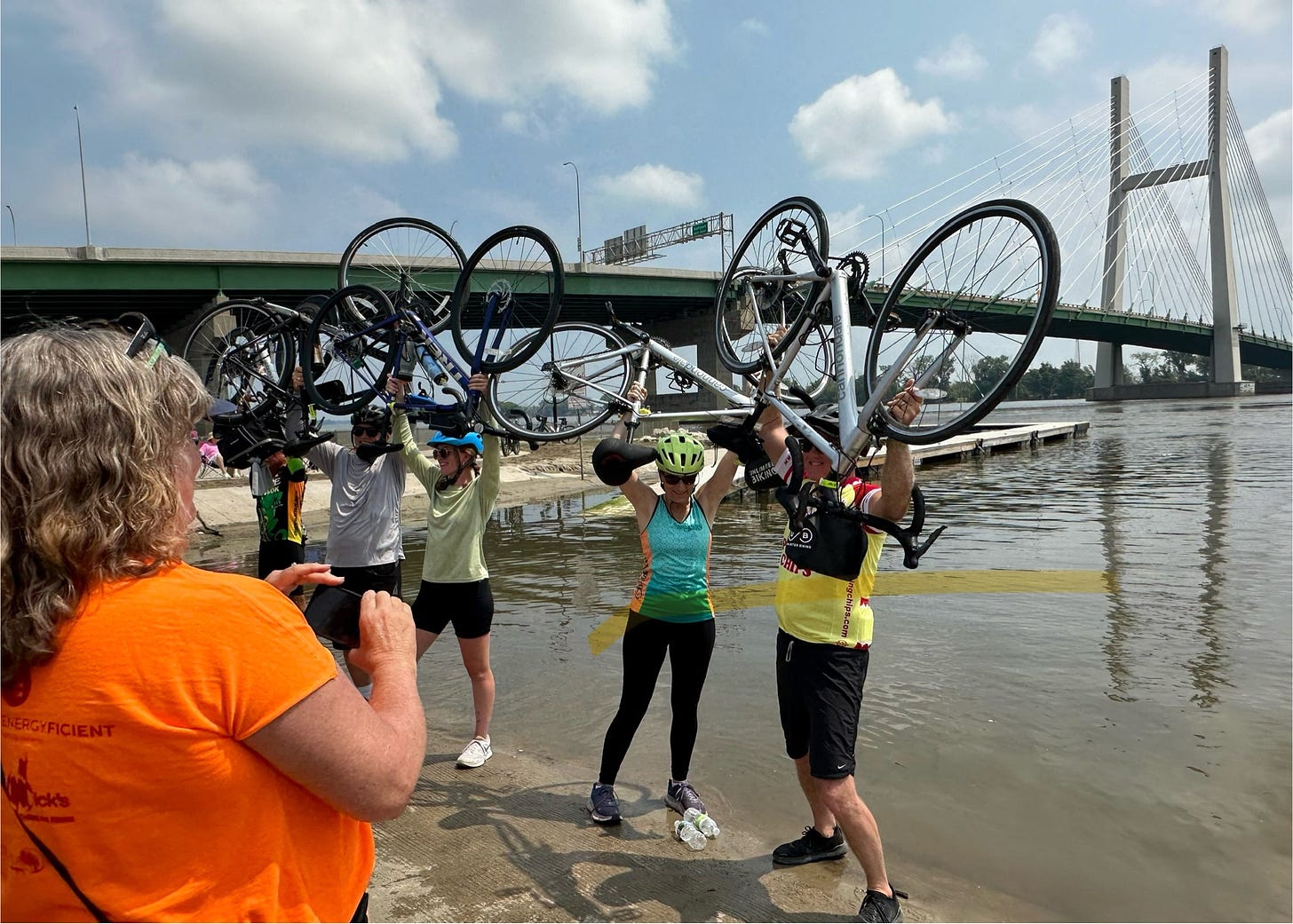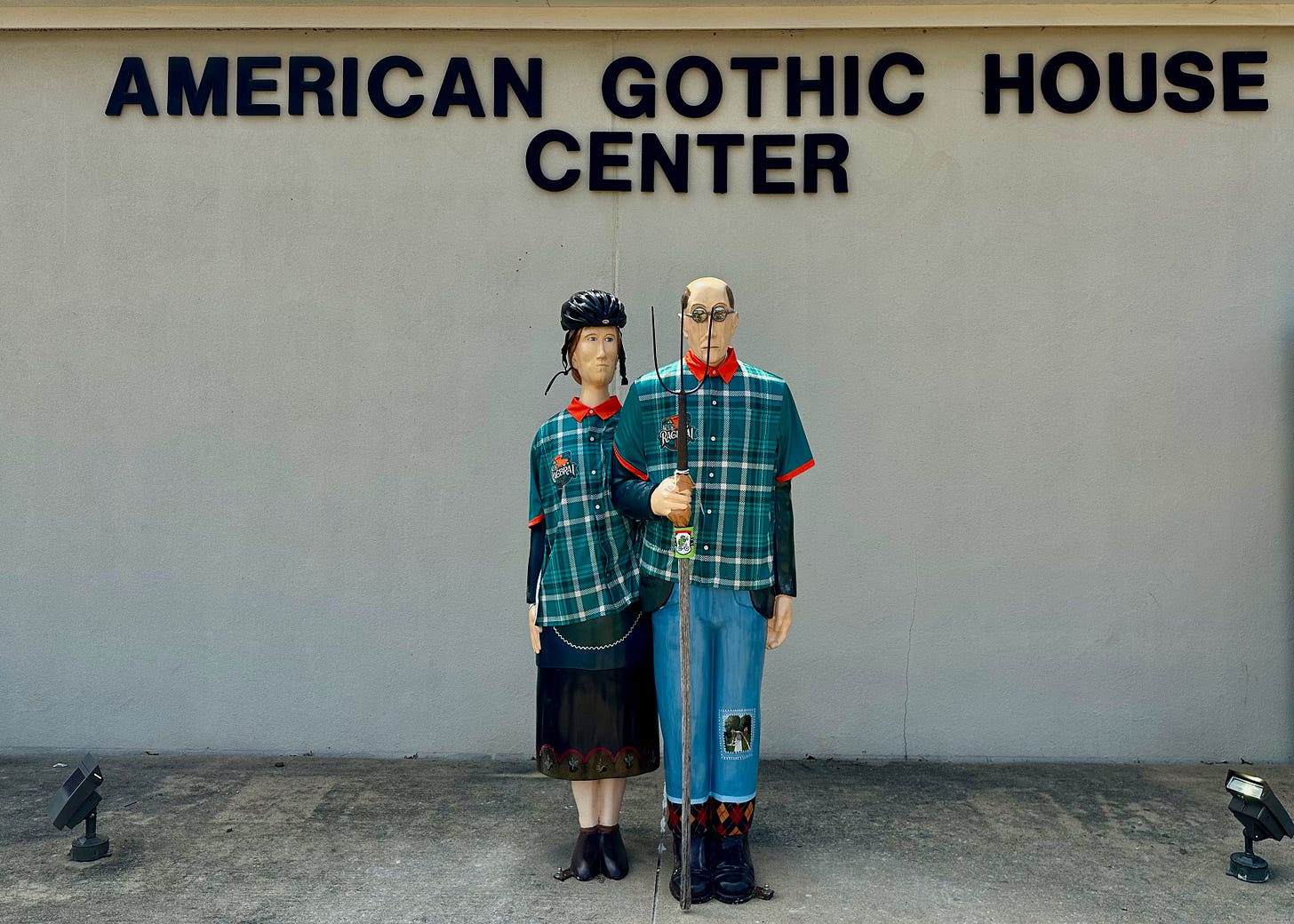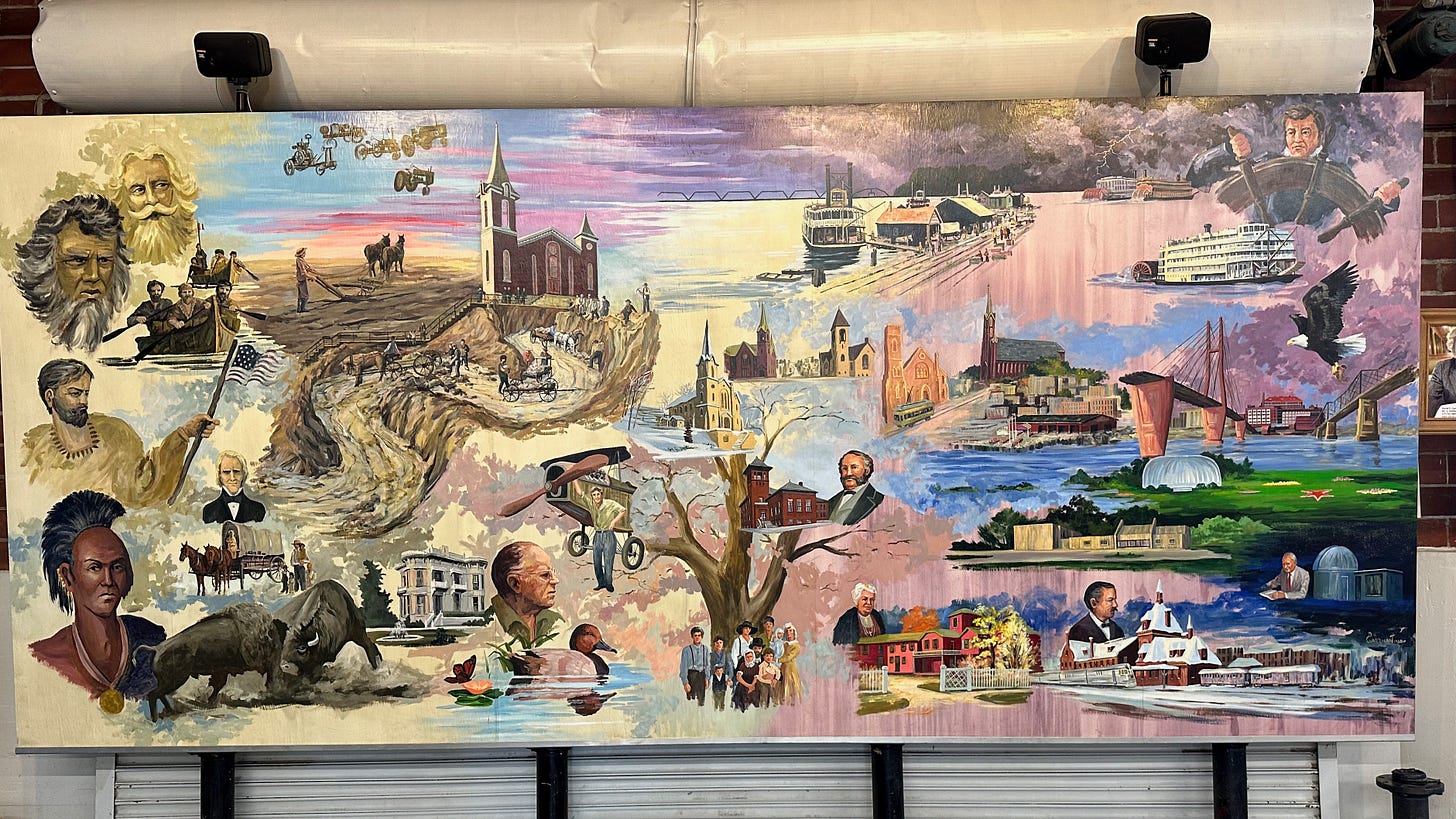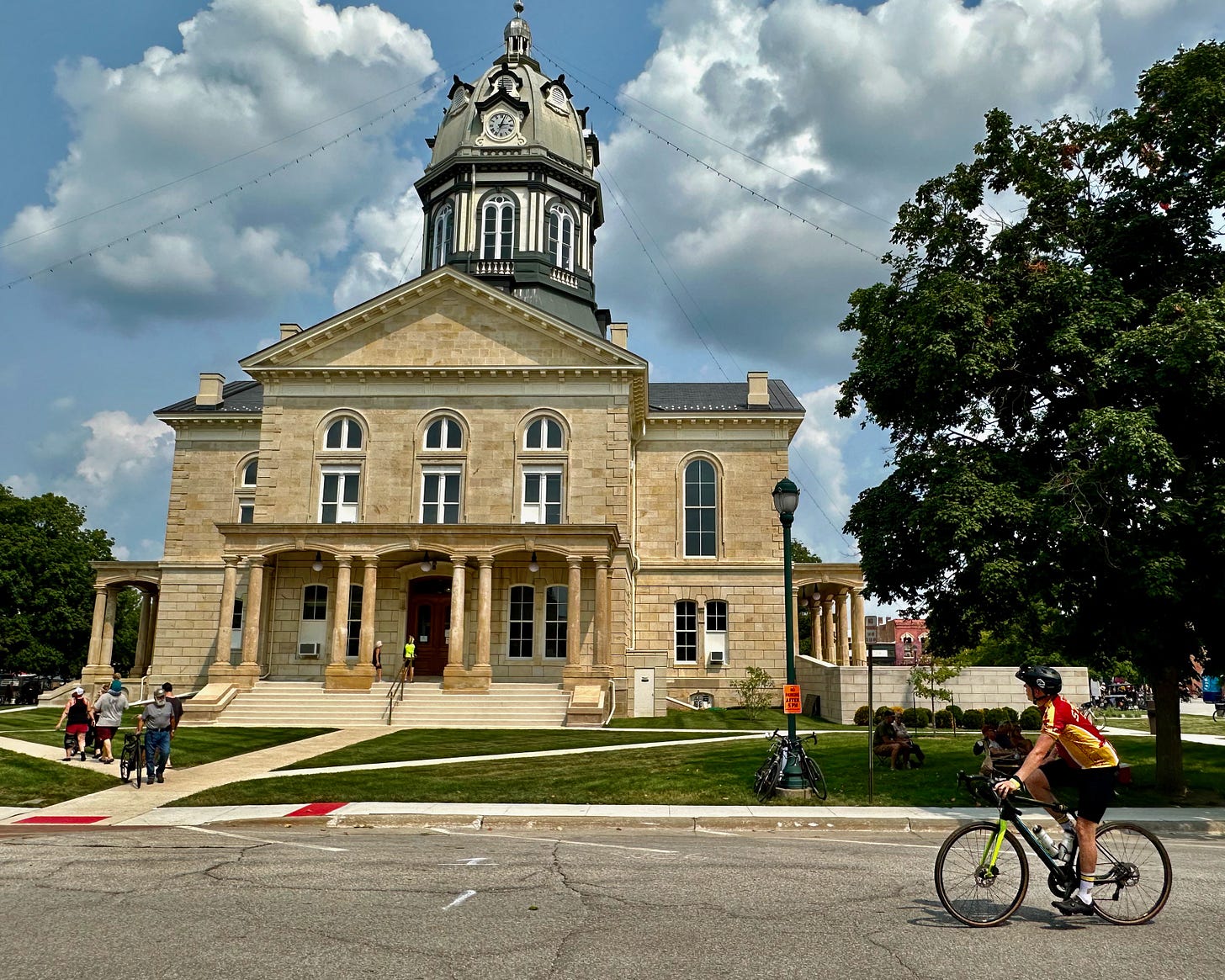RAGBRAI After the Caucuses. Biking across a Red State in an Election Year (Part 5, The End)
What happens when people vote against their interests? Town to town, it's evident in Iowa
We are pausing our regularly scheduled programming for a special election essay. In addition to voting, after canvassing the state of Iowa in July 2024 for the (Des Moines) Register’s Great Bicycle Ride Across Iowa (RAGBRAI), I penned a 10,000-word essay on the reasons a vote for Trump is a vote against American and international interests, as I saw it across Iowa.
Day 8, Burlington to Fort Madison: Transportation and The End
One of RAGBRAI’s many main mission is to promote bicycling thruways and scenic routes throughout Iowa. So far, Iowa has twenty-five hundreds miles of trails across the state — far from the U.S.’s top cities of Minneapolis, Chicago, and Seattle, and a poor comparison to the nearly twenty-two thousand miles of trails in The Netherlands. But Iowa — like most of the U.S. — is a car and pick-up truck state.
The Iowa Department of Transportation doesn’t keep income or racial statistics on its riders, only studies of small cities and only positive studies, apparently: Iowa City's fare-free transit program saw a forty-four percent increase in ridership in the first three months. But that doesn’t solve the problems of miles between towns or people struggling to get to work and school on time, or lastly, trying to get to Iowa from another state. And lastly, it doesn’t put to rest the conclusion that Black, Latino, and other minorities are the chief users of city buses.
In a mirroring of the rest of the U.S. — and the world — Iowa’s population is continuing to migrate toward the state’s nine metropolitan areas, which each have a total population of at least fifty thousand. Within those small cities, Iowa has nineteen urban public transit systems covering about fifty-six thousand square miles. By 2050, racial and ethnic minorities in Iowa are projected to account for almost twenty-five percent of the state’s total population. Minority groups in Iowa are more likely to have a lower median household income and take a mode other than a personal automobile to work than nonminority populations. Of course, the transportation department aims to increase bus routes, provide translated transit maps, and offer more jobs to the number of people working in the transportation sector. Already, Iowa City has a shortage of bus drivers and the Des Moines Area Regional Transit Authority (DART) will cut down its buses by forty percent by next year because of it. In fact, DART has been struggling for months to find other new funding sources to address a $2.7 million shortfall, despite being the only mode of public transportation in Iowa's capital city. That number could grow to $7.7 million, without more public funding.
Quite possibly the most relevant example of Iowa’s transportation problem became apparent to me on the Sunday night after the race in Fort Madison, Iowa. I had gone for a run and decided to take a detour past the Old Santa Fe railroad. The Santa Fe's only stop in Iowa, Fort Madison was once one of the major rail centers in southeastern Iowa, which included a former passenger depot, as well as a freight station. The Santa Fe travels rolls through Fort Madison at least twenty times per day, but for one unlucky man who “thought it could be fun to travel with his daughter from New Orleans to Iowa,” nothing much else does. From the Amtrak station waiting area, I heard a “Ms., Ms.,” before I stopped to see the man, Roger, smoking. “Do you have a car? Could you please help with a ride to my motel? There is not an Uber for hours and I called the police, but they are not allowed to take me.” I ran back to the hotel and found my father — who despite his RAGBRAI friendliness — was not keen on taking a unknown man six miles to a motel on the edge of town. He removed his Rolex watch and hid his wallet before the poor man climbed into our SUV and offered us twenty dollars for the trouble. My father returned to the motel the next morning and took him back to the station for his train. The Amtrak train was four hours late… again.

Amtrak has been working on adding new rails, and the calls for train routes to Chicago to St. Louis, Las Vegas to Los Angeles have hit fever pitch. A new rail route from St. Paul, Minnesota to Chicago was able to turn a profit in just eleven days, bringing in $600,000 in operating revenue during May and costing $500,000 in operating expenses. Borealis, served 6,600 passengers in the short time in which it was operational last summer. Transportation Secretary Pete Buttigieg has called a U.S. high-speed rail network a “no-brainer” — and Amtrak is planning to introduce the new high-speed Acela in late 2024 — but the train will remain limited to Amtrak's busy Northeast Corridor between Boston and Washington D.C. via New York and Philadelphia. Another private company, Brightline, has started another high-speed rail to link Las Vegas and Los Angeles starting from 2028. Aside from that, while the total number of miles travelled by Americans has increased, miles taken on the train have remained almost stagnant in the last decades, likely because of high prices and too few, as well as slow, connections on the Amtrak network. Meanwhile, individual road transport is still the major way Americans get around the country. In 2022, the latest year on record, cars, trucks and motorcycles clocked in around 4.3 trillion passenger miles (miles travelled per vehicle multiplied by number of passengers).
And on August 4, my father and I — following two weeks, a dozen relative visits, some real estate business of dad’s, and with Harris and Trump on the hustings again — pulled onto Interstate-44 West back to Tulsa. It was about ninety days until the election and both candidates would circle the state many more times. But as Iowa is not a swing state, neither candidate would spend much more time in the towns we had visited. Trump has locked-in Iowa and the state’s fate is sealed: so loyal were Trump’s supporters in Iowa that 71 percent of them told pollsters in January that they would consider him fit to serve as president even if he were to be convicted of a crime, which he was on May 30, becoming the first U.S. president with several felonies on his record. They also found that loyalty to Trump in Iowa was also fuelled by a deep pessimism about the state of the country and its future prospects.

But over the course of the last eight years, Iowa has become Trump country — he is their great hope. The New York Times has credited Trump from taking Iowa from a “swing state into a GOP stronghold… No other state has shifted as hard toward Republicans in the same period.” When asked by friends how my trip to the States went, I pull out my iPhone and scroll through photos of Iowa. Three stand out: three vintage cars, adorned with life-size cut outs of Donald Trump or Donald and Melania Trump in the drivers’ seats, standing prominently in the front yard of a house just outside Knoxville, Iowa. These type of cutouts were displayed prominently across the state during my time there, like devotionals to their saviour. But if only these Iowans looked around, turned inward, reflected, and acknowledged how they have tarnished their communities, then maybe they actually could fix them on their own. Maybe all of America could.






